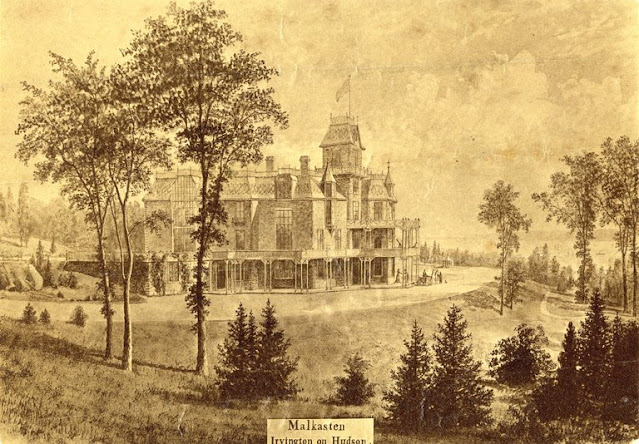Malkasten: Studio and home of renowned artist Bierstadt fell to flames
"Malkasten," just inside Tarrytown's southern border, was the 19th century retreat of renowned landcape artist Albert Bierstadt.
The Prussian-born Bierstadt (1830-1902) was a member of the Hudson River School, artists who studied their craft along the Hudson River. Their style featured romantic, glowing light, a movement called luminism. He later gained fame for his landscapes of the American West and was also considered part of the Rocky Mountain School.
 |
Prussian emigre Albert Bierstadt (1830-1902) is pictured ca. 1870. (Wikimedia Commons, public domain)
He emigrated to New Bedford, Mass., with his family when he was one year old and showed promise as an artist even as a child. He began painting with oil at age 21 and he returned to Dusseldorf, Germany in 1853 to study and teach. He spent four years in Germany before returning to New Bedford in 1857.
He traveled throughout the western U.S. in 1859 and 1863 and returned each time to complete landscapes at his Manhattan studio that won him international recognition.
Bierstadt was drafted in 1863 at the height of the Civil War but did not serve in the Union Army because he legally paid a substitute to serve in his place.
His career took off financially around this time. He sold one of his landscapes, “The Rocky Mountains, Lander's Peak," in 1865 for $25,000 (about $425,000 today).
 |
Albert Bierstadt’s oil-on-canvas landscape “The Rocky Mountains, Lander's Peak” sold for a then-record $25,000 ($423,000 today) in 1865, a record for an American painting at the time. (Metropolitan Museum of Art, public domain) |
In 1867 he began a two-year tour of Europe to keep international focus on his work. The trip began with a private reception with Queen Victoria in London at which he displayed a pair of his landscape paintings.
Some credited his brilliant images of the American West with fueling immigration from Europe to the wide open spaces of the western U.S.
Bierstadt was no shrinking violet and smashed the stereotype of the starving artist. If his subjects were grand in scale, so was his sales sense. He self-promoted his exhibitions which were heavily advertised and generated strong ticket sales. He was a prolific artist, completing more than 500 paintings in his lifetime.
His fame grew despite a scandal that would have kept today’s pop culture news outlets abuzz for months. In 1863, he traveled through the West with author, explorer and journalist Fitz Hugh Ludlow. Bierstadt fell for Ludlow’s wife, Rosalie Osborne Ludlow, who ended up marrying Bierstadt in 1866 within a year of divorcing Ludlow.
 |
Rosalie Osborn Ludlow Bierstadt is shown in an 1863
photo at the time she began a scandalous affair with Albert Bierstadt, her husband Fitz Hugh Ludlow's friend and traveling companion. She would divorce her husband and go on to marry Bierstadt in 1866, living with him at Malkasten. (Wikimedia Commons, public domain)
Bierstadt took advantage of his new-found wealth and prepare for his upcoming nuptials by buying land in Irvington in 1865 and building his new mansion, originally called “Hawksrest” but later changed to “Malkasten” (“paintbox” in German) in 1866, completing it just in time to welcome his new bride.
The house itself was massive, with a footprint of 75 feet by 100 feet, and housed Bierstadt’s 3-story, 30-foot-wide studio. In his blog “Hudson Valley Ruins,” author Rob Yasinsac reports that the studio opened onto a library/music room and when glass doors were opened between the two rooms, it opened to one room of 70 feet in length “... a good size space to view his canvases of up to 15 feet by 9 feet.”
 |
Pictured is Albert Bierstadt's studio at Malkasten, part
of a 3.5 inch by 7 inch stereocard. His studio was destroyed
by fire in 1882, along with many of the items shown
in the picture. (Bierstadt Collection 1863-1957. Brooklyn
Libraries, Special Collections)
 |
“Sailboats on the Hudson at Irvington,” painted in 1889. (Wikimedia Commons, public domain) |
During the Bierstadts’ time in Nassau, Malkasten caught fire and was destroyed. The fire broke out on Nov. 10, 1882, the day after summer renter Henry J. Chapman Jr. completed his rental and left the estate. It ended the Bierstadts’ years in Irvington/Tarrytown and the Malkasten mansion was never rebuilt.
The fire destroyed more than a building. According to the New York Times story on Nov. 11, 1882:
Bierstadt himself had fallen out of favor with art critics and collectors in the late 1870s and his financial fortunes had declined, leaving the Malkasten estate to suffer. The property would eventually be purchased and absorbed into the Halsted/King estate on the north side of East Sunnyside Lane that is now part of the Tarrytown House Estate property.
AUTHOR'S NOTE: For more information about Albert Bierstadt and a look at his complete works, 467 of his paintings, visit albertbierstadt.org












Comments
Post a Comment
If you would like to weigh-in, feel free ...